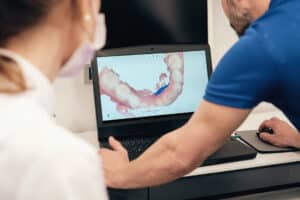Here in Midtown Toronto, we’re used to the different ways that advanced technology has affected our lives. Whether ordering food, conducting research, or planning a route, digital tools enhance the way we’ve traditionally carried out our daily tasks.
The same is true with dentistry. Dental techniques have evolved over the past several centuries, and modern technology has helped make the patient experience faster, safer, and more convenient than ever before.
Digital Tools Improving Patient Experience
The technology we employ at Yonge Eglinton Dental is designed to improve the patient experience while enhancing our ability to access comprehensive data on their oral health.
Here are two examples of advanced techniques our team utilizes when treating our patients.
Intraoral scanners for comfort and accuracy
Remember those messy impression materials that dentists have used in the past? Thanks to intraoral scanners, they are staying in the past!
These small, handheld devices use light-based technology to create highly accurate 3D digital models of a patient’s teeth and soft tissues. It works by taking thousands of images per second, which are processed by software to stitch together a detailed 3D virtual replica of the oral cavity.
This image is then displayed in real-time on a screen, allowing us to see the details of the mouth and helping to educate the patient about their oral health.
We utilize these digital scans to diagnose conditions, plan treatments, and fabricate custom dental restorations, including crowns, bridges, veneers, and clear aligners. The images also enable us to assess gum recession, monitor changes in soft tissue over time, and design custom mouthguards.
Sharing these images with labs also improves turnaround times on dental appliances and offers a more streamlined workflow compared to conventional methods.
3D imaging for dental implants and crowns
Attaching dental implants or crowns demands accuracy, precision, and uncompromising attention to detail. 3D imaging technology makes the work easier to complete successfully.
3D imaging in Toronto typically utilizes Cone Beam Computed Tomography (CBCT) technology, which employs a cone-shaped X-ray beam to capture images from multiple angles. These images are then reconstructed by specialized software to create a comprehensive, 3D model of the patient’s mouth.
This detailed view provides a clear view of the jawbone’s exact height and width, the quantity and quality of available bone for implant attachment, and the identification of subtle issues or complex root structures that might not be visible on conventional 2D X-rays. The image also enhances the precision of implant placement, ensures an exact fit of a crown, and helps us avoid critical structures like nerves and the maxillary sinuses during dental procedures.
For the patient, the results are shorter surgery times, reduced post-operative discomfort, and reduced surgical anxiety.
What Technology Means for Midtown Patients
If you live and work in Midtown Toronto, you know how fast-paced life can be. Between office hours, business meetings, family commitments, everyday errands, and your social life, time can definitely be short.
That is why dental technology is so vital to our local community. It allows for faster, safer, and more comfortable visits, enabling you to receive real-time dental diagnoses sooner and make treatment decisions based on real-time data. Should you need restorative dental work, our in-office innovations reduce the waiting time for your new appliances to arrive and improve attachment precision.
At Yonge Eglinton Dental, we are always interested in adopting new ways to elevate the patient experience. However, we also understand that while advanced tech is important, our true strength lies in creating a warm, welcoming atmosphere every time you visit our office.
After all, technology may constantly be changing, but our personal, empathetic approach to patient care never will.
Enjoy safe, convenient digital dentistry in Toronto with the Experts at Yonge Eglinton Dental
Contact our dental health team when you are ready to optimize your oral health. We will work together to ensure your teeth and gums look great and are as strong and healthy as possible. Make an appointment for an office visit today by calling our office at 416-932-2222 or booking online. We look forward to seeing you!
Are you concerned about visiting the dentist? Read about how we protect the health and safety of our patients and staff so your family can seek proper dental care with peace of mind.
FAQs about advanced technology in dentistry
Why is advanced technology important in modern dentistry?
Advanced dental technology allows dentists to detect problems earlier, treat them more precisely, and make patient visits faster and more comfortable.
How does technology improve my dental experience as a patient?
Modern technology means fewer invasive procedures and shorter appointments. For example, digital impressions eliminate messy molds, and 3D imaging helps dentists plan your treatment with pinpoint accuracy. It all adds up to more comfort, convenience, and confidence when visiting the dentist.
Why do dentists invest in new technology?
Dentists use advanced technology to provide safer, more predictable, and longer-lasting results. New tools also help them diagnose hidden issues that older methods might miss, allowing them to preserve more of your teeth and avoid future complications.
Is new dental technology safe?
Yes. All modern dental technologies used in Canada are carefully tested and approved for safety and effectiveness. Digital tools often reduce exposure to radiation, minimize discomfort, and improve the precision of your treatment compared to traditional methods.
What is an intraoral scanner, and how does it help me?
An intraoral scanner is a small handheld device that creates a 3D digital model of your teeth. It is faster, more accurate, and much more comfortable, especially for patients with strong gag reflexes or sensitive teeth.
How does 3D imaging help with dental implants and crowns?
3D imaging gives your dentist a complete, high-definition view of your teeth, jawbone, and surrounding tissues. This allows for precise planning of implants and perfectly fitted crowns, ensuring a more natural look, a better bite, and a smoother healing process.








